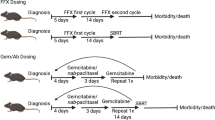Summary
We investigated the antitumor effects of intratumoral (IT) injection of mitomycin-C (MMC), 5-fluorouracil (5FU), adriamycin (ADR), cisplatin (CDDP), streptozotocin (STZ), and interleukin-2 (IL-2) on well-differentiated pancreatic ductal adenocarcinoma (WD PaCa), a solid tumor model in the Syrian golden hamster. The growth of established palpable WD PaCa was not suppressed by intraperitoneal (IP) injection of these anticancer agents, whereas IT injection of MMC (1.0 mg/kg or more), 5FU (12.5 mg/kg or more), and CDDP (2.5 mg/kg or more) caused significant and marked suppression. The growth of established palpable WD PaCa was transiently suppressed by 50 Gy of local irradiation. The antitumor effect of irradiation was not enhanced by it injection of MMC before irradiation, whereas it was significantly enhanced by it injection after irradiation. Intraperitoneal injection of IL-2 (5 or 10 µg/d, 18 d) slightly suppressed the growth of established palpable tumors, but it injection of IL-2 caused significant and marked suppression, eliminating the tumor in 10–20% of the animals. Findings in this animal model of pancreatic cancer suggest that it treatment of anticancer agents or IL-2 might become an effective therapy for advanced pancreatic cancer.
Similar content being viewed by others
References
Hinuma S, Naruo K, Shiho and Tsukamoto K. Characteristic of murine non-specific killer cells induced in vivo by recombinant human interleukin-2. Immunology 1986; 59: 251–259.
Rockwell SC, Kallman RF, and Fajardo LF. Characteristics of a serially transplanted mouse mammary tumor and its tissue-culture-adapted derivative. J. Natl. Cancer Inst. 1972; 49: 735–749.
Cubilla AL and Fitzgerald PJ. Cancer of pancreas (nonendocrine):a suggested morphologic classification. Semin. Oncol. 1979; 6: 285–297.
Bukowski RM, Schacter LP, Groppe CW, Hewlett JS, Weick JK and Livingston RB. Phase II study of 5-fluorouracil, Adriamycin, mitomycin-C and streptozotocin for advanced pancreatic cancer. Cancer 1982; 50: 197–200.
Bukowski RB, Balcerzak SP, O’bryan RM, Bonnet JD, and Chen TT. Randomized trial of 5-fluorouracil and mitomycin-C with or without streptozotocin for advanced pancreatic cancer. Cancer 1983; 52: 1577–1582.
Freireich EJ, Gahan EA, Rail DP, Schmidt LH, and Skipper HE. Quantitative comparison of toxicity of anticancer agents in mouse, rat, hamster, dog, monkey and man. Cancer Chemother. Rep. 1966; 50: 219–244.
Chang BK and Gutman R. Chemotherapy of pancreatic adenocarcinoma: Initial report on two transplantable models in the Syrian hamster. Cancer Res. 1982; 42: 2666–2670.
Moriai T, Otake Y, Koike D, Hayashi S, Ohyama K, Takebe T, and Ishii K. Intratumoral injection therapy of mitomycin-C adsorbed to activated carbon particles under ultrasound guidance for pancreatic cancer. Jpn. J. Gastroenterol. 1985; 82: 2994.
Moriai T and Ishii K. Intratumoral injection therapy of mitomycin-C adsorbed to activated carbon particles under ultrasound guidance for local chemotherapy of pancreatic cancer. Gastroenterol. Surg. Semin. (Japan) 1986; 25: 227–238.
Selch MT and Parker RG. Results in the management of locally unresectable pancreatic carcinoma. Am. J. Clin. Oncol. 1986; 9: 139–145.
Cheever MA, Thompson JA, Kern DE, and Greenberg PD. Interleukin 2 (IL 2) administered in vivo:influence of IL 2 route and timing on T cell growth. J. Immunol. 1985; 134: 3895–3900.
Rosenberg SA, Mule JJ, Spiess PJ, Reichert CM, and Schwarz SL, Regression of established pulmonary métastases and subcutaneous tumor mediated by the systemic administration of high-dose recombinant interleukin-2. J. Exp. Med. 1985; 161: 1169–1188.
Silagi S and Schsefer AE. Successful immunotherapy of mouse melanoma and sarcoma with recombinant interleukin-2 and cyclophosphamide. J. Biol. Response Mod. 1986; 5: 411–422.
Vaage J. Local and systemic effect during interleukin-2 therapy of mouse mammary tumors. Cancer Res. 1987; 47: 4296–4298.
Rosenberg SA, Spiess P, and Lafreniere R. A new approach to the adoptive immunotherapy of cancer with tumor-infiltrating lymphocytes. Science 1986; 233: 1318–1321.
Morgan DA and Ruscetti FW. Selective in vitro growth of T lymphocytes from normal human marrow. Science 1976; 193: 1007–1008.
Handa K, Suzurki R, Marsui H, Shimizu Y, and Kumagai K. Natural killer (NK) cells as responder to interleukin 2 (IL-2). II. IL 2 induced-interferon γ production. J. Immunol. 1983; 130: 988–992.
Author information
Authors and Affiliations
Rights and permissions
About this article
Cite this article
Moriai, T., Takebe, T. & Makino, I. Experimental study on multidisciplinary treatment of pancreatic cancer. Int J Pancreatol 6, 161–179 (1990). https://doi.org/10.1007/BF02924286
Received:
Revised:
Accepted:
Issue Date:
DOI: https://doi.org/10.1007/BF02924286




